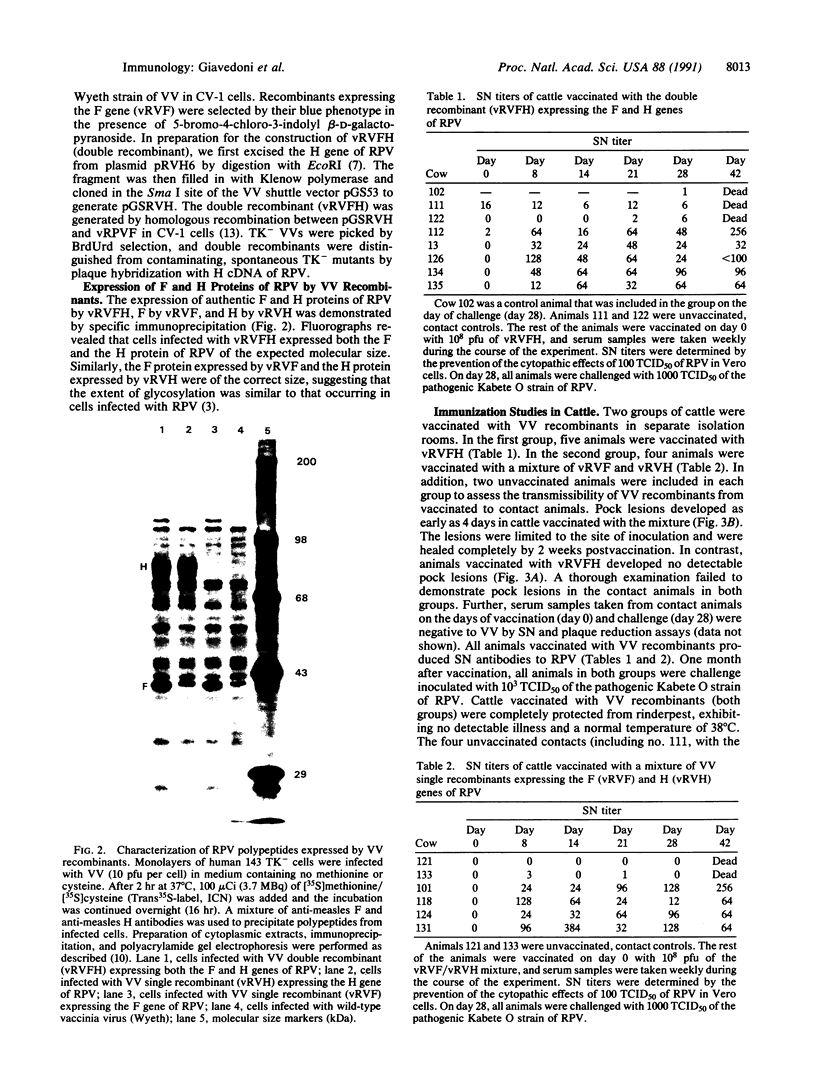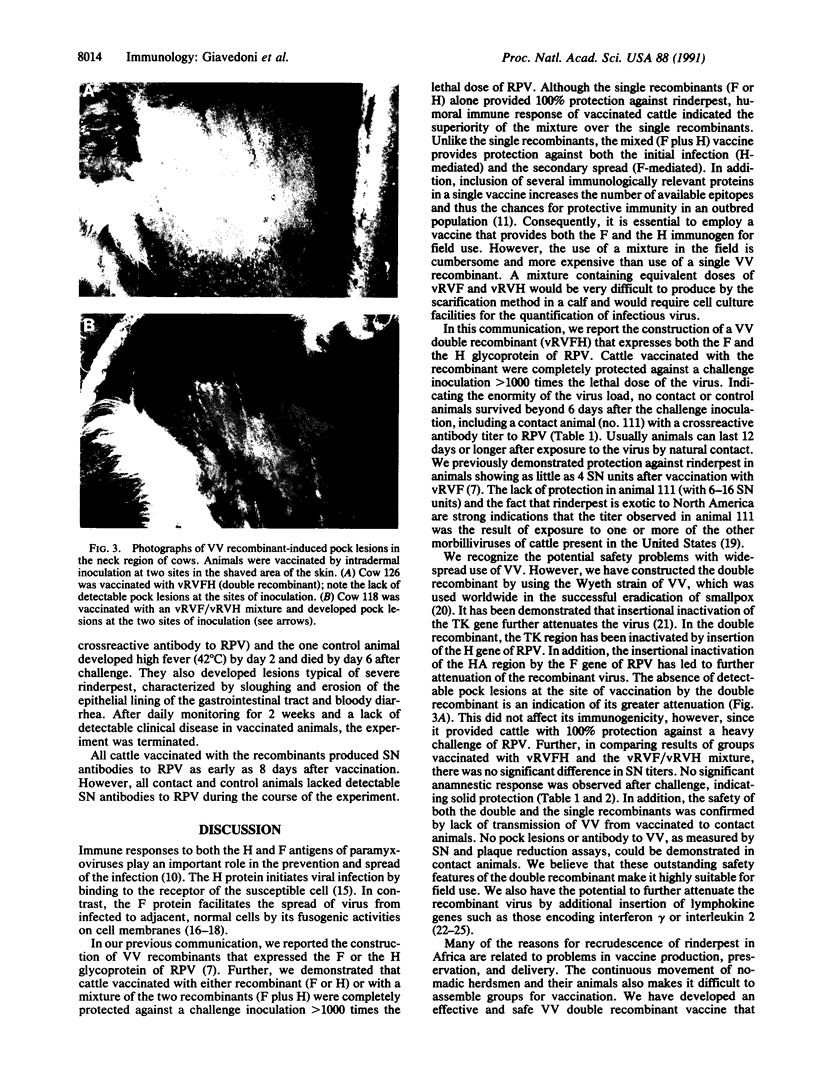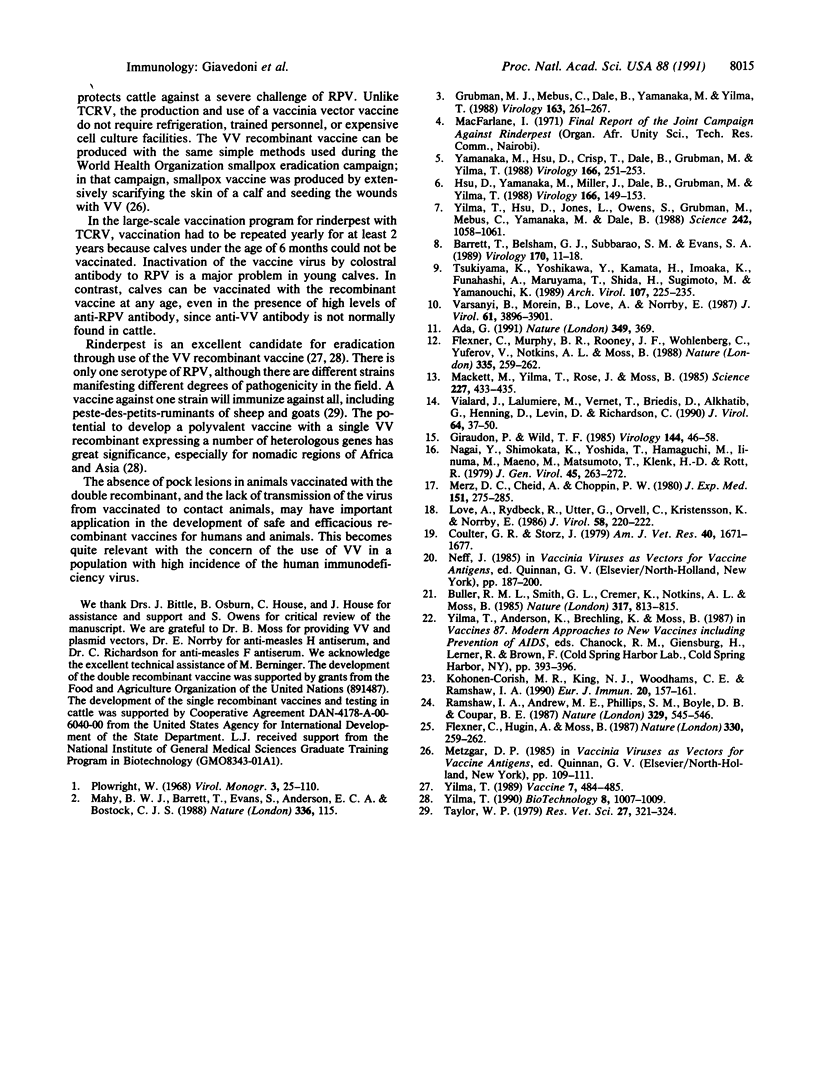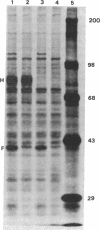Abstract
Rinderpest is a highly contagious viral disease of ruminants with greater than 95% morbidity and mortality. We have constructed an infectious vaccinia virus recombinant that expresses both the fusion (F) gene and the hemagglutinin (H) gene of rinderpest virus. The Wyeth strain of vaccinia virus was used for the construction of the recombinant. Cattle vaccinated with the recombinant virus were 100% protected from challenge inoculation with greater than 1000 times the lethal dose of rinderpest virus. No transmission of recombinant vaccinia virus from vaccinated animals to contact animals was observed. The lyophilized form of vaccinia virus is thermostable and allows circumvention of the logistical problems associated with the distribution and administration of vaccines in the arid and hot regions of Asia and Africa. The insertional inactivation of both the thymidine kinase and the hemagglutinin genes of vaccinia virus led to increased attenuation of the virus; this was manifested by the lack of detectable pock lesions in vaccinated animals. This approach may have wide application in the development of safe and efficacious recombinant vaccines for humans and animals. This becomes quite relevant with the concern of the use of vaccinia virus in a population with high incidence of the human immunodeficiency virus.
Full text
PDF




Images in this article
Selected References
These references are in PubMed. This may not be the complete list of references from this article.
- Ada G. Vaccine development. Real and imagined dangers. Nature. 1991 Jan 31;349(6308):369–369. doi: 10.1038/349369a0. [DOI] [PubMed] [Google Scholar]
- Barrett T., Belsham G. J., Subbarao S. M., Evans S. A. Immunization with a vaccinia recombinant expressing the F protein protects rabbits from challenge with a lethal dose of rinderpest virus. Virology. 1989 May;170(1):11–18. doi: 10.1016/0042-6822(89)90346-2. [DOI] [PubMed] [Google Scholar]
- Buller R. M., Smith G. L., Cremer K., Notkins A. L., Moss B. Decreased virulence of recombinant vaccinia virus expression vectors is associated with a thymidine kinase-negative phenotype. 1985 Oct 31-Nov 6Nature. 317(6040):813–815. doi: 10.1038/317813a0. [DOI] [PubMed] [Google Scholar]
- Characterization of a seal morbillivirus. Nature. 1988 Nov 10;336(6195):115–116. doi: 10.1038/336115a0. [DOI] [PubMed] [Google Scholar]
- Coulter G. R., Storz J. Identification of a cell-associated morbillivirus from cattle affected with malignant catarrhal fever: antigenic differentiation and cytologic characterization. Am J Vet Res. 1979 Dec;40(12):1671–1677. [PubMed] [Google Scholar]
- Flexner C., Hügin A., Moss B. Prevention of vaccinia virus infection in immunodeficient mice by vector-directed IL-2 expression. Nature. 1987 Nov 19;330(6145):259–262. doi: 10.1038/330259a0. [DOI] [PubMed] [Google Scholar]
- Flexner C., Murphy B. R., Rooney J. F., Wohlenberg C., Yuferov V., Notkins A. L., Moss B. Successful vaccination with a polyvalent live vector despite existing immunity to an expressed antigen. Nature. 1988 Sep 15;335(6187):259–262. doi: 10.1038/335259a0. [DOI] [PubMed] [Google Scholar]
- Giraudon P., Wild T. F. Correlation between epitopes on hemagglutinin of measles virus and biological activities: passive protection by monoclonal antibodies is related to their hemagglutination inhibiting activity. Virology. 1985 Jul 15;144(1):46–58. doi: 10.1016/0042-6822(85)90303-4. [DOI] [PubMed] [Google Scholar]
- Grubman M. J., Mebus C., Dale B., Yamanaka M., Yilma T. Analysis of the polypeptides synthesized in rinderpest virus-infected cells. Virology. 1988 Apr;163(2):261–267. doi: 10.1016/0042-6822(88)90265-6. [DOI] [PubMed] [Google Scholar]
- Hsu D., Yamanaka M., Miller J., Dale B., Grubman M., Yilma T. Cloning of the fusion gene of rinderpest virus: comparative sequence analysis with other morbilliviruses. Virology. 1988 Sep;166(1):149–153. doi: 10.1016/0042-6822(88)90156-0. [DOI] [PubMed] [Google Scholar]
- Kohonen-Corish M. R., King N. J., Woodhams C. E., Ramshaw I. A. Immunodeficient mice recover from infection with vaccinia virus expressing interferon-gamma. Eur J Immunol. 1990 Jan;20(1):157–161. doi: 10.1002/eji.1830200123. [DOI] [PubMed] [Google Scholar]
- Löve A., Rydbeck R., Utter G., Orvell C., Kristensson K., Norrby E. Monoclonal antibodies against the fusion protein are protective in necrotizing mumps meningoencephalitis. J Virol. 1986 Apr;58(1):220–222. doi: 10.1128/jvi.58.1.220-222.1986. [DOI] [PMC free article] [PubMed] [Google Scholar]
- Mackett M., Yilma T., Rose J. K., Moss B. Vaccinia virus recombinants: expression of VSV genes and protective immunization of mice and cattle. Science. 1985 Jan 25;227(4685):433–435. doi: 10.1126/science.2981435. [DOI] [PubMed] [Google Scholar]
- Merz D. C., Scheid A., Choppin P. W. Importance of antibodies to the fusion glycoprotein of paramyxoviruses in the prevention of spread of infection. J Exp Med. 1980 Feb 1;151(2):275–288. doi: 10.1084/jem.151.2.275. [DOI] [PMC free article] [PubMed] [Google Scholar]
- Nagai Y., Shimokata K., Yoshida T., Hamaguchi M., Iinuma M., Maeno K., Matsumoto T., Klenk H. D., Rott R. The spread of a pathogenic and an apathogenic strain of Newcastle disease virus in the chick embryo as depending on the protease sensitivity of the virus glycoproteins. J Gen Virol. 1979 Nov;45(2):263–272. doi: 10.1099/0022-1317-45-2-263. [DOI] [PubMed] [Google Scholar]
- Ramshaw I. A., Andrew M. E., Phillips S. M., Boyle D. B., Coupar B. E. Recovery of immunodeficient mice from a vaccinia virus/IL-2 recombinant infection. Nature. 1987 Oct 8;329(6139):545–546. doi: 10.1038/329545a0. [DOI] [PubMed] [Google Scholar]
- Taylor W. P. Protection of goats against peste-des-petits-ruminants with attenuated rinderpest virus. Res Vet Sci. 1979 Nov;27(3):321–324. [PubMed] [Google Scholar]
- Tsukiyama K., Yoshikawa Y., Kamata H., Imaoka K., Asano K., Funahashi S., Maruyama T., Shida H., Sugimoto M., Yamanouchi K. Development of heat-stable recombinant rinderpest vaccine. Arch Virol. 1989;107(3-4):225–235. doi: 10.1007/BF01317919. [DOI] [PubMed] [Google Scholar]
- Varsanyi T. M., Morein B., Löve A., Norrby E. Protection against lethal measles virus infection in mice by immune-stimulating complexes containing the hemagglutinin or fusion protein. J Virol. 1987 Dec;61(12):3896–3901. doi: 10.1128/jvi.61.12.3896-3901.1987. [DOI] [PMC free article] [PubMed] [Google Scholar]
- Vialard J., Lalumière M., Vernet T., Briedis D., Alkhatib G., Henning D., Levin D., Richardson C. Synthesis of the membrane fusion and hemagglutinin proteins of measles virus, using a novel baculovirus vector containing the beta-galactosidase gene. J Virol. 1990 Jan;64(1):37–50. doi: 10.1128/jvi.64.1.37-50.1990. [DOI] [PMC free article] [PubMed] [Google Scholar]
- Yamanaka M., Hsu D., Crisp T., Dale B., Grubman M., Yilma T. Cloning and sequence analysis of the hemagglutinin gene of the virulent strain of rinderpest virus. Virology. 1988 Sep;166(1):251–253. doi: 10.1016/0042-6822(88)90168-7. [DOI] [PubMed] [Google Scholar]
- Yilma T. D. Prospects for the total eradication of rinderpest. Vaccine. 1989 Dec;7(6):484–485. doi: 10.1016/0264-410x(89)90266-1. [DOI] [PubMed] [Google Scholar]
- Yilma T. A modern vaccine for an ancient plague: rinderpest. Biotechnology (N Y) 1990 Nov;8(11):1007–1009. doi: 10.1038/nbt1190-1007. [DOI] [PubMed] [Google Scholar]
- Yilma T., Hsu D., Jones L., Owens S., Grubman M., Mebus C., Yamanaka M., Dale B. Protection of cattle against rinderpest with vaccinia virus recombinants expressing the HA or F gene. Science. 1988 Nov 18;242(4881):1058–1061. doi: 10.1126/science.3194758. [DOI] [PubMed] [Google Scholar]





